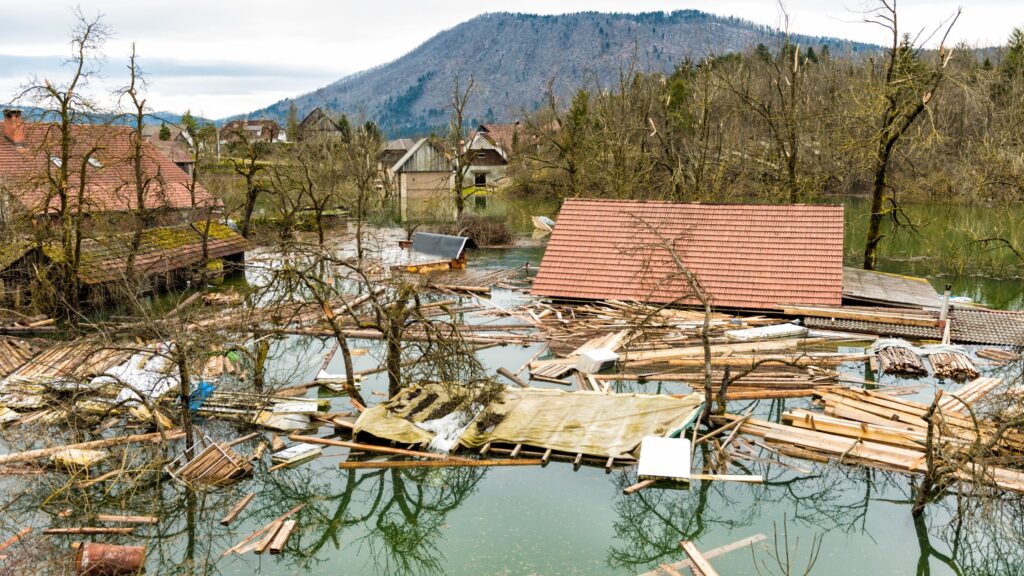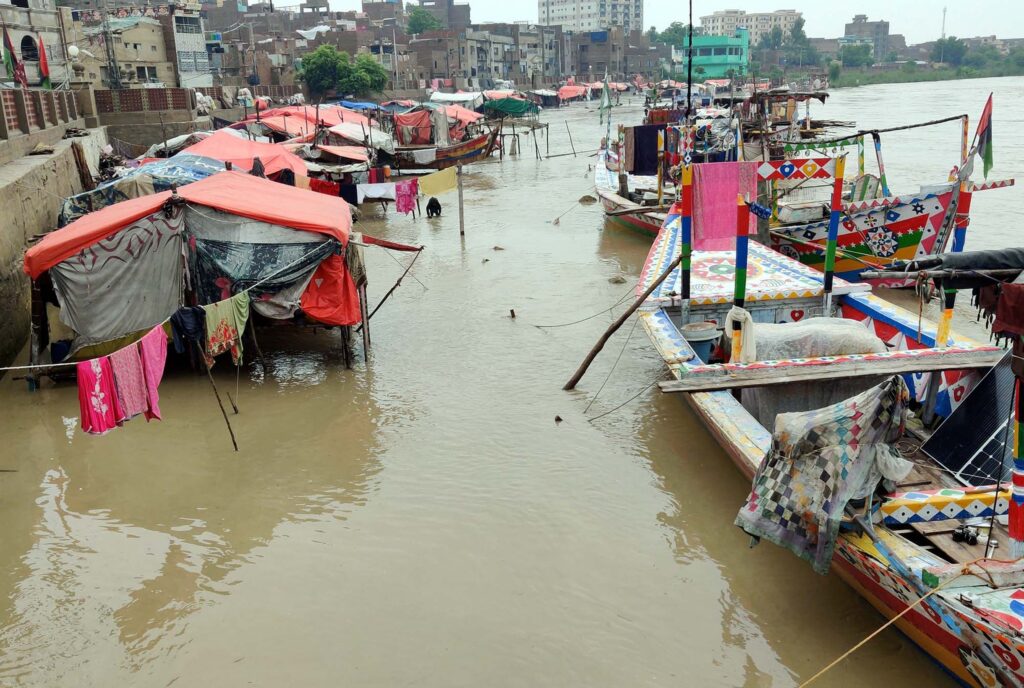Rapid Review of Flood Damage and Loss in Pakistan
By Mr. Tom Caley, Dr. Nimra Choudhary and Ms. Anusha Manahil
Since mid-June 2022, record monsoon rains have submerged up to a third of Pakistan causing more than 1500 deaths, 1.4 million homes destroyed and up to $10 billion in damage (Thomas, 2022). Before the rains struck, a series of heatwaves had caused soil to dry, leaving little capacity to absorb the massive amounts of floodwater (Cabot, 2022).

Image 1: Flood damage in Pakistan (© Shutterstock, 2022)
Areas of the country have received seven to eight times the normal amount of rainfall for this time of year (Reuters, 2022) and the humanitarian situation is worsening as factors including lost crops and livestock, damaged infrastructure, rising debt and inflation, and increased provincial vulnerability converge.
Pakistan’s National Disaster Management Authority (NDMA) has provided daily “monsoon sitrep” figures on cumulative deaths and injury since mid-June (NDMA, 2022) when deluges started. As of 22nd September, a total of 1,596 deaths are reported and 12,863 injured. The report disaggregates data by gender, age group, and region, revealing that children account for over a third of total deaths. The most affected regions for deaths and injuries are Balochistan (304 deaths), Khyber Pakhtunkhwa (306 deaths), and especially southern Sindh province (724 deaths to date).
The United Nations Office for the Coordination of Humanitarian Affairs (OCHA) report, current as of September 16th, (OCHA, 2022) runs a figure of 1,500 deaths, also highlighting the ongoing harm to livelihoods and livestock (936,000 animals lost), and lost roads and bridges in Sindh. The number of dead is fast approaching that of Pakistan’s “worst natural disaster in national history”: the summer monsoon flooding of 2010, where 2,000 were estimated to have died, and over six million left homeless (Khan, 2020, p947).
Sindh province contains the most populous and industrialised city in the nation, Karachi, but also suffers increased vulnerability in the hinterland. Within a picture of urban-rural socioeconomic divides (Skidmore, 2021) the landscape of the countryside consists of alluvial plains surrounding the Indus river valley, where a “high concentration of districts, communities, villages, settlements and rural poor people the river banks” (Khan, 2020, p947).
Existing health services are heavily under strain. According to Mirza Nasir-ud-Din Mashhood Ahmad, special secretary at the Ministry of National Health Services, infrastructure submerging and damage will prevent access to a vulnerable population and hamper an “already ailing health system” (Ebrahim, 2022) operating within a “relatively fragile regulatory framework” (Skidmore, 2021).
Human Rights Watch (HRW) reports that more than 1,000 health facilities in Sindh and 198 in Balochistan have been partially or fully destroyed (Sifton and Ijaz, 2022), a development with significant ramifications for the estimated 73,000 women expected to give birth in the next month. HRW notes most births in Pakistan happen at home, and the damage to roads and communication networks will also affect access to contraception and other reproductive health services.

Image 2: Sukkur, Sindh, Pakistan on 22 August 2022 (© Shutterstock, 2022)
Sindh accounts for 72% of standing water countrywide (Ahmed, 2022). Such conditions provide favourable breeding grounds for mosquitoes and increase the risk of diseases such as dengue, the fastest spreading tropical disease in the world known for its debilitating pain and fever (Staff Report, 2022). With around 33 million people affected by the floods, other diseases such as diarrhoea, malaria and Covid-19 are likely to spike in the coming weeks (Ebrahim, 2022).
Given the United Nations ‘Sendai Framework for Disaster Risk Reduction 2015-2030’ first two global targets A and B are to reduce global disaster mortality and reduce the number of people affected globally by 2030 (UNDRR, 2015), several key recommendations are suggested to save lives.
Vulnerability is a key factor in flooding impact, with Balochistan (Kurtzer and Abdullah, 2022) and Sindh (Khan, 2020) provinces presenting higher poverty levels and inundation damage exposure. Political attention must now turn towards strengthening governance of health services and rebuilding a regulatory framework for resilience and development in both urban and rural populations
Special priority must be given to dealing with the immediate threat of waterborne (including cholera, malaria and diarrhoea) and vectorborne diseases (such as dengue and malaria), with the Ministry of National Health Services Regulation and Coordination leading on improved prevention and protection plans for the provinces.
Finally, with the nation suffering from high inflation, lost crops and infrastructure and heightened food insecurity (Kurtzer and Abdullah, 2022) Pakistan’s crisis management needs to be pushed up the global agenda. With entire villages underwater, and with livelihoods, roads and health centres washed away, the nation is in need of immediate international support so that indirect deaths can be avoided.
Acknowledgement
The authors would like to thank Drs Nibedita Ray-Bennett and Madhulika Sahoo for their comments on the initial draft.
Sources
Ahmed, A. (2022) Floods double protection risks for women and children. Available at: https://www.dawn.com/news/1710660/floods-double-protection-risks-for-women-and-children (Accessed 20 September 2022)
Cabot, C. (2022) First came the heatwaves, then the floods: Why Pakistan is on the front line of the climate crisis. Available at: https://www.france24.com/en/asia-pacific/20220831-first-came-the-heat-waves-then-the-floods-why-pakistan-is-on-the-frontline-of-the-climate-crisis (Accessed 20 September 2022)
Ebrahim, Z. (2022) Flood-hit Pakistan faces spread of infectious diseases. Available at: https://www.scidev.net/global/news/flood-hit-pakistan-faces-spread-of-infectious-diseases/ (Accessed 20 September 2022)
Khan, N. (2020) ‘Sindh in Karachi: A topography of separateness, connectivity and juxtaposition’ in Politics and Space, 38 (5), pp. 938-957.
National Disaster Management Authority (2022) Sitrep 2022. Available at: http://cms.ndma.gov.pk/page/sitrep-2022 (Accessed 20 September 2022)
Kurtzer, J. and Abdullah, H.F. (2022) Pakistan’s Deadly Floods Pose Urgent Questions on Preparedness and Response. Available at: https://www.csis.org/analysis/pakistans-deadly-floods-pose-urgent-questions-preparedness-and-response (Accessed 20 September 2022)
Office for the Coordination of Humanitarian Affairs (OCHA) (2022) Pakistan: 2022 Monsoon Floods – Situation Report No. 6 (As of 16 September 2022). Available at: https://reliefweb.int/report/pakistan/pakistan-2022-monsoon-floods-situation-report-no-6-16-september-2022 (Accessed 20 September 2022)
Reuters (2022) New research: Climate change likely made Pakistan’s extreme rainfall more intense. Available at: https://indianexpress.com/article/explained/explained-climate/pakistans-extreme-rainfall-climate-change-study-explained-8156063/ (Accessed 20 September 2022)
Sifton, J. and Ijaz, S. (2022) Flood-Affected Women in Pakistan Need Urgent Help. Available at: https://www.hrw.org/news/2022/09/02/flood-affected-women-pakistan-need-urgent-help (Accessed 20 September 2022)
Skidmore, Z. (2021) Sindh – A province in turmoil. Available at:
https://peaceforasia.org/sindh-a-province-in-turmoil/ (Accessed 20 September 2022)
Staff Report (2022) Pakistan sees surge in dengue cases. Available at: https://www.pakistantoday.com.pk/2022/09/17/pakistan-sees-surge-in-dengue-cases/ (Accessed 20 September 2022)
Tewari, S. (2022) Pakistan floods put pressure on faltering economy. Available at: https://www.bbc.com/news/world-asia-62830771 (Accessed 20 September 2022)
Thomas, M. (2022) Disease warning as Pakistan flood death toll rises. Available at: https://www.bbc.com/news/world-asia-62779533 (Accessed 20 September 2022)
United Nations Office for Disaster Risk Reduction (UNDRR) (2015) What is the Sendai Framework for Disaster Risk Reduction? Available at: https://www.undrr.org/implementing-sendai-framework/what-sendai-framework (Accessed 23 September 2022)

